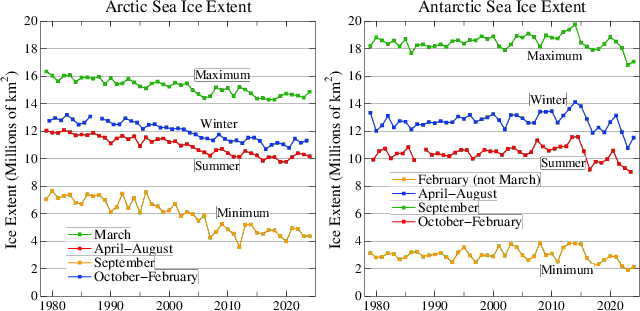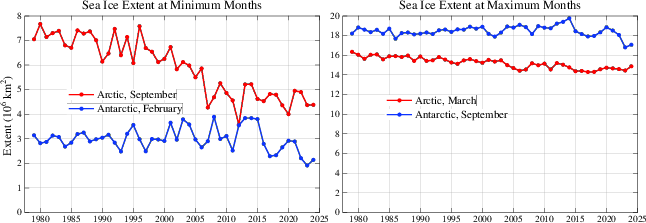Sea Ice Area
The area of sea ice cover is an important climate feedback. Figure 20 in "Storms" shows the
large decrease of Arctic sea ice area that occurred at the end of the warm season in 2007. This
sudden loss of sea ice is a cause of concern because sea ice area causes an amplifying climate
feedbacks. As the area of ice decreases, increased absorption of sunlight by the darker ocean
causes more sea ice melting. The huge sea ice loss of 2007 caused some scientists and other
people to speculate that all Arctic warm-season sea ice may be lost within five years.
Updates of Fig. 20 in "Storms", and also for the maximum months.
(Also in PDF. Last Modified: 2024/03/02, Data through February 2024.
)
Sea ice cover is probably not that unstable. The figure below shows Arctic and Antarctic sea ice
cover in the summer months of maximum insolation, as well as the ice cover in the months with
maximum and minimum ice area. It is the sea ice area in April-August, when the sun is high in
the Arctic sky, that determines the degree of sea ice feedback in the Northern Hemisphere. This figure
suggests that the September 2007 sea ice minimum did not have a correspondingly large effect
on the sea ice area at the time of maximum insolation.

Arctic and Antarctic sea ice extent at their minimums, maximums and seasons of maximum and minimum insolation.
(Also in PDF Last Modified: 2024/03/02, Data through February 2024.)
The "extent" includes the area near the pole not
imaged by the sensor. It is assumed to be entirely ice covered with at
least 15% concentration. [This statement and data are of
National Snow and Ice Data Center, Boulder, CO; https://masie_web.apps.nsidc.org/pub//DATASETS/NOAA/G02135/.
It seems likely that all September Arctic sea ice may be gone within a few decades, if human-
made greenhouse gases continue to increase. On the other hand, as discussed in "Storms", if
Earth's energy balance is restored by decreasing atmospheric carbon dioxide to 350 ppm or less,
it may be possible to stabilize or increase the area of Arctic ice.
See more fiugres.
Reference:
Fetterer, F., K. Knowles, W. Meier, and M. Savoie. 2002, updated daily. Sea Ice Index. [indicate subset used]. Boulder, Colorado USA: National Snow and Ice Data Center. http://dx.doi.org/10.7265/N5QJ7F7W.
Last Modified: 2024/04/02, Data through March 2024.

